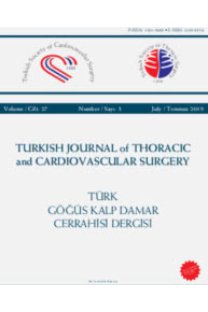Roles of ephrin-B2+ and CD34+ cells in post-angioplasty pericardial patch repair
Ephrin B2+ and CD34+ hücrelerinin anjiyoplasti sonrası perikard yama tamirindeki rolü
___
- 1. Langer R, Tirrell DA. Designing materials for biology and medicine. Nature 2004;428:487-92.
- 2. Jaganathan SK, Supriyanto E, Murugesan S, Balaji A, Asokan MK. Biomaterials in cardiovascular research: applications and clinical implications. Biomed Res Int 2014;2014:459465.
- 3. Muto A, Nishibe T, Dardik H, Dardik A. Patches for carotid artery endarterectomy: current materials and prospects. J Vasc Surg 2009;50:206-13.
- 4. Williams C, Xie AW, Emani S, Yamato M, Okano T, Emani SM, et al. A comparison of human smooth muscle and mesenchymal stem cells as potential cell sources for tissue-engineered vascular patches. Tissue Eng Part A 2012;18:986-98.
- 5. Park JW, Leithäuser B, Rittger H, Brachmann J. Treatment strategies for prevention of cardioembolic stroke in atrial fibrillation. Clin Hemorheol Microcirc 2010;46:251-64.
- 6. Rustinart GJ. Multiple aneurysms of the right coronary artery; death from a ruptured aneurysm of the abdominal aorta. J Am Med Assoc 1952;149:1129-31.
- 7. Li X, Guo Y, Ziegler KR, Model LS, Eghbalieh SD, Brenes RA, et al. Current usage and future directions for the bovine pericardial patch. Ann Vasc Surg 2011;25:561-8.
- 8. Goldman KA, Su WT, Riles TS, Adelman MA, Landis R. A comparative study of saphenous vein, internal jugular vein, and knitted Dacron patches for carotid artery endarterectomy. Ann Vasc Surg 1995;9:71-9.
- 9. Li X, Jadlowiec C, Guo Y, Protack CD, Ziegler KR, Lv W, et al. Pericardial patch angioplasty heals via an Ephrin-B2 and CD34 positive cell mediated mechanism. PLoS One 2012;7:38844.
- 10. Luo J, Korossis SA, Wilshaw SP, Jennings LM, Fisher J, Ingham E. Development and characterization of acellular porcine pulmonary valve scaffolds for tissue engineering. Tissue Eng Part A 2014;20:2963-74.
- 11. Boldt J, Lutter G, Pohanke J, Fischer G, Schoettler J, Cremer J, et al. Percutaneous tissue-engineered pulmonary valved stent implantation: comparison of bone marrow-derived CD133+-cells and cells obtained from carotid artery. Tissue Eng Part C Methods 2013;19:363-74.
- 12. Bond R, Rerkasem K, Naylor AR, Aburahma AF, Rothwell PM. Systematic review of randomized controlled trials of patch angioplasty versus primary closure and different types of patch materials during carotid endarterectomy. J Vasc Surg 2004;40:1126-35.
- 13. Inoue T, Croce K, Morooka T, Sakuma M, Node K, Simon DI. Vascular inflammation and repair: implications for re-endothelialization, restenosis, and stent thrombosis. JACC Cardiovasc Interv 2011;4:1057-66.
- 14. Bai H, Kuwahara G, Wang M, Brownson KE, Foster TR, Yamamoto K, et al. Pretreatment of pericardial patches with antibiotics does not alter patch healing in vivo. J Vasc Surg 2014;pii:S0741-5214(14)01862-X.
- 15. Strange G, Brizard C, Karl TR, Neethling L. An evaluation of Admedus tissue engineering process-treated (ADAPT) bovine pericardium patch (CardioCel) for the repair of cardiac and vascular defects. Expert Rev Med Devices 2015;12:135-41.
- 16. Gale NW, Holland SJ, Valenzuela DM, Flenniken A, Pan L, Ryan TE, et al. Eph receptors and ligands comprise two major specificity subclasses and are reciprocally compartmentalized during embryogenesis. Neuron 1996;17:9-19.
- 17. Swift MR, Weinstein BM. Arterial-venous specification during development. Circ Res 2009;104:576-88.
- 18. Kuijper S, Turner CJ, Adams RH. Regulation of angiogenesis by Eph-ephrin interactions. Trends Cardiovasc Med 2007;17:145-51.
- 19. Rockman CB, Halm EA, Wang JJ, Chassin MR, Tuhrim S, Formisano P, et al. Primary closure of the carotid artery is associated with poorer outcomes during carotid endarterectomy. J Vasc Surg 2005;42:870-7.
- 20. Hristov M, Weber C. Endothelial progenitor cells in vascular repair and remodeling. Pharmacol Res 2008;58:148-51.
- 21. Burt RK, Testori A, Oyama Y, Rodriguez HE, Yaung K, Villa M, et al. Autologous peripheral blood CD133+ cell implantation for limb salvage in patients with critical limb ischemia. Bone Marrow Transplant 2010;45:111-6.
- 22. Hristov M, Weber C. Endothelial progenitor cells: characterization, pathophysiology, and possible clinical relevance. J Cell Mol Med 2004;8:498-508.
- 23. Si TG. The experimental study of relation between sex hormone and restenosis after angioplasty. [Doctoral dissertation], Tianjin: Tianjin Medical University; 2003.
- 24. Lee JM, Choe W, Kim BK, Seo WW, Lim WH, Kang CK, et al. Comparison of endothelialization and neointimal formation with stents coated with antibodies against CD34 and vascular endothelial-cadherin. Biomaterials 2012;33:8917-27.
- 25. Ederle J, Dobson J, Featherstone RL, Bonati LH, van der Worp HB, de Borst GJ, et al. Carotid artery stenting compared with endarterectomy in patients with symptomatic carotid stenosis (International Carotid Stenting Study): an interim analysis of a randomised controlled trial. Lancet 2010;375:985-97.
- ISSN: 1301-5680
- Yayın Aralığı: 4
- Başlangıç: 1991
- Yayıncı: Bayçınar Tıbbi Yayıncılık
Banu SALEPCİ, Elif PARMAKSIZ TORUN, Ali FİDAN, Sevda CÖMERT ŞENER, Benan ÇAĞLAYAN
Is isolated dextrocardia a feature of left-sided Poland's syndrome?
Turgut IŞITMANGİL, Nurettin YİYİT, Serkan ARIBAL
Gül Deniz YILMAZ YELVAR, Yasemin ÇIRAK, Zehra KARAHAN, İlknur ERDEN, Ufuk DEMİRKILIÇ
Levent CANSEVER, Celalettin İbrahim KOCATÜRK, Yaşar SÖNMEZOĞLU, Ümit AYDOĞMUŞ, Servet ÖZDEMİR, Mehmet Ali BEDİRHAN
Pulmonary sublobar resections in children with congenital cystic adenomatoid malformations
Abdullah YILDIZ, Başak ERGİNEL, Canan TANIK, Ali İhsan DOKUCU, Nihat SEVER, Çetin Ali KARADAĞ, Melih AKIN
Bidirectional cavopulmonary anastomosis without cardiopulmonary bypass
Muhammet AKYÜZ, Mahir BALAKISHIEV, Onur IŞIK, Yüksel ATAY, Mehmet Fatih AYIK
Paramedian retroperitoneal approach for revascularization of aortoiliac occlusive disease
Fırat DURNA, Serkan GİRGİN, Mohammed ALSHALALDEH, Bilgin EMRECAN
Roles of ephrin-B2+ and CD34+ cells in post-angioplasty pericardial patch repair
